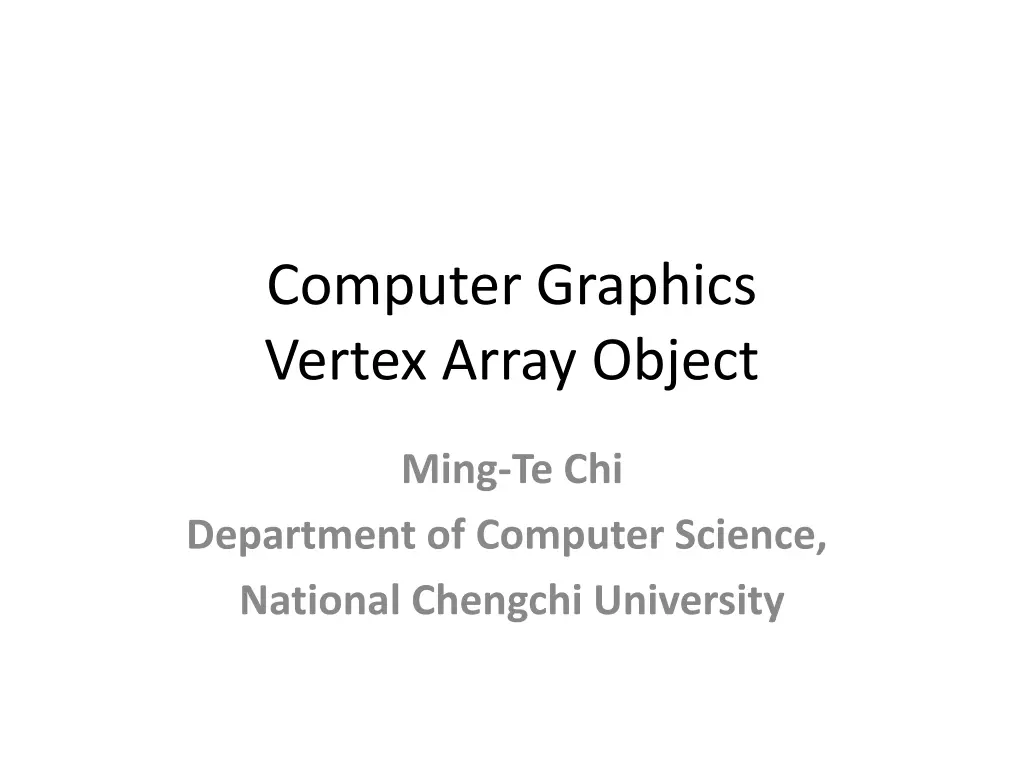
Modern OpenGL Concepts Explained
Explore modern OpenGL concepts such as Vertex Array Objects (VAO), Immediate Mode, and Display Lists. Learn about rendering bottlenecks, geometric primitives, and vertex arrays with practical examples. Discover the significance of VAOs with Vertex Buffer Objects (VBO) for rendering primitives efficiently in OpenGL. Stay updated with post-OpenGL 3.3 advancements and understand the core components required for specifying vertex data in contemporary OpenGL programming.
Uploaded on | 0 Views
Download Presentation

Please find below an Image/Link to download the presentation.
The content on the website is provided AS IS for your information and personal use only. It may not be sold, licensed, or shared on other websites without obtaining consent from the author. If you encounter any issues during the download, it is possible that the publisher has removed the file from their server.
You are allowed to download the files provided on this website for personal or commercial use, subject to the condition that they are used lawfully. All files are the property of their respective owners.
The content on the website is provided AS IS for your information and personal use only. It may not be sold, licensed, or shared on other websites without obtaining consent from the author.
E N D
Presentation Transcript
Computer Graphics Vertex Array Object Ming-Te Chi Department of Computer Science, National Chengchi University
Bottleneck in rendering Application Client side GPU Server side
OpenGL Geometric Primitives All geometric primitives are specified by vertices GL_LINES GL_POINTS GL_POLYGON GL_LINE_STRIP GL_LINE_LOOP GL_TRIANGLES GL_QUADS GL_QUAD_STRIP GL_TRIANGLE_FAN GL_TRIANGLE_STRIP
Immediate mode Application Client side GPU glBegin(GLenum mode); glVertex3f( ); glEnd(); Server side glBegin(); glEnd();
Display lists Preprocess Display glCallList(mylist); Gluint mylist; glNewList(mylist, GL_COMPILE); some glcode glEndList();
Vertex Arrays void glVertexPointer(GLint size, GLenum type, GLsizei stride, const GLvoid * pointer); define an array of vertex data void glDrawArrays(GLenum mode, GLint first, GLsizei count); render primitives from array data
Vertex Arrays- example const int SMALL_STAR=100; Glfloat vSmallStars[SMALL_STAR*2]; //assign position into vSmallStars glEnableClientState(GL_VERTEX_ARRAY); glVertexPointer(2, GL_FLOAT, 0, vSmallStars); glDrawArrays(GL_POINTS, 0, SMALL_STAR);
Vertex Array Object (VAO) In modern OpenGL, VAO with VBO is the main way to render primitive. A VAO is an OpenGL Object that encapsulates all of the state needed to specify vertex data. Note that VAOs do not contain the arrays themselves; the arrays are stored in Buffer Objects
VAO triangle example // An array of 3 vectors which represents 3 vertices static const GLfloat g_vertex_buffer_data[] = { -1.0f, -1.0f, 0.0f, 1.0f, -1.0f, 0.0f, 0.0f, 1.0f, 0.0f, }; ShaderInfo shaders[] = { { GL_VERTEX_SHADER, "triangles.vert" }, { GL_FRAGMENT_SHADER, "triangles.frag" }, { GL_NONE, NULL } }; GLuint program = LoadShaders(shaders); glUseProgram(program);
// Generate and Bind VAO GLuint VertexArrayID; glGenVertexArrays(1, &VertexArrayID); glBindVertexArray(VertexArrayID); Application Client side GPU Server side Glfloat [] VAO VBO // This will identify our vertex buffer GLuint vertexbuffer; // Generate 1 buffer, put the resulting identifier in vertexbuffer glGenBuffers(1, &vertexbuffer); // The following commands will talk about our 'vertexbuffer' buffer glBindBuffer(GL_ARRAY_BUFFER, vertexbuffer); // Give our vertices to OpenGL. glBufferData(GL_ARRAY_BUFFER, sizeof(g_vertex_buffer_data), g_vertex_buffer_data, GL_STATIC_DRAW);
GPU - Server side VAO in display() VAO program Vertex shader VBO 001010101 010101010 glUseProgram(program); in vec3 position in vec3 color // 1st attribute buffer : vertices glBindBuffer(GL_ARRAY_BUFFER, vertexbuffer); glVertexAttribPointer( 0, // attribute 0. No particular reason for 0, but must match the layout in the shader. 3, // size GL_FLOAT, // type GL_FALSE, // normalized? 0, // stride (void*)0 // array buffer offset ); glEnableVertexAttribArray(0); // Draw the triangle ! Starting from vertex 0; 3 vertices total -> 1 triangle glDrawArrays(GL_TRIANGLES, 0, 3); glDisableVertexAttribArray(0);
















